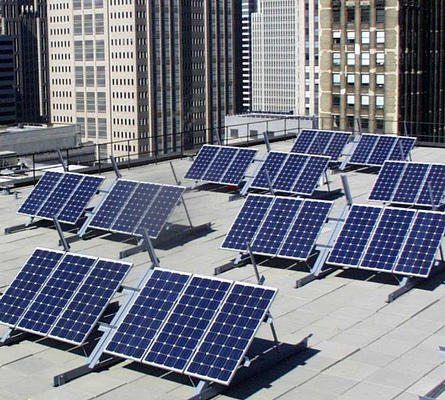
Everyone knows that electricity bills are getting higher and higher, and often we’re burning up precious fossil fuels to create this power. Now Solar Panels are becoming a viable solution even for the average consumer these days but tend to be expensive, delicate, require specialised installation and look pretty ugly up there on the roof,
Well at CEATAC, 3M demonstrated it’s new special film developed to coat ordinary, existing windows and convert them into solar panels. Made from an organic photovoltaic material the film not only generates energy from sunlight but also absorbs over 90% of infrared light, resulting in a cooling effect as well.
The film’s narrow, translucent green strips have gaps between them and are glued onto the window in large patches. Unlike solar paneling, the film is easy to install and according to 3M senior manager Ashuiro Aoyagi can be installed by the average person. It’s worth noting though that the film only generates about 20 percent of the power generated by a regular solar panel so a 1m square only generates roughly enough power to charge a smartphone under direct sunlight.
Pricing and availability are not yet available.
See 3M’s Solar Energy Site for more information on their currently available solutions.



Gadgeteer Comment Policy - Please read before commenting
I do love my gadgeteer guys but they do blow it from time to time.
Minimal research cost projections, 20% the power, half the cost,
charges a smartphone, payback about a half century, life expectancy four years. At least you guys can pick up extra work with Obama’s energy department. Viable is not the word, substitute mor—nah, I enjoy you most of the time.
Solar power has never been profitable except for remote locations where it would cost thousands to install normal power. But you never know what is going to happen to normal power.
I do not agree with you baldspot, Dear its been proven that solar has been growing… 🙂
My recollection is that the most cost-effective PV cells are about 10-15% efficient (the most efficient cells are about 25%, but cost is much higher), solar insolation at ground level near the equator around noon is about 1 kilowatt/m^2 => 100-150 watts/m^2. 20% of that is 20-30 watts/m^2, which should be enough to run a low power laptop and far more than enough to charge a smartphone.
I suspect a good chunk of their inefficiency is that window panes are vertical, which is far from the best angle to catch the sun at any latitude except near the north or south poles.
We’re not there yet, but solar power is sure a good way to go.
Even with the low efficiency of current panels, a small percentage of the African sahara would suffice to power Europe if it were full of solar panels.
The political aspects are more important then the energy aspects until now.
Who’s knows what future will bring … 🙂